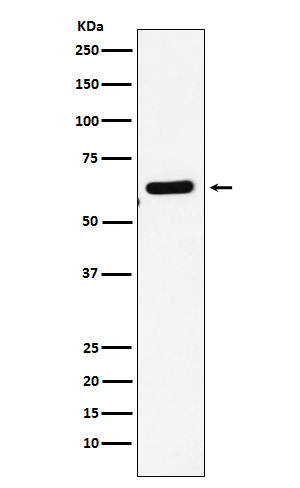
| WB | 1/1000-1/2000 | Human,Mouse,Rat |
| IF | 1/20-1/50 | Human,Mouse,Rat |
| IHC | IHC:1/100-1/200;IHF:1/50-1/200 | Human,Mouse,Rat |
| ICC | 1/50-1/200 | Human,Mouse,Rat |
| FCM | 1/20-1/100 | Human,Mouse,Rat |
| Elisa | 咨询技术 | Human,Mouse,Rat |
| Aliases | EHD1; H PAST; hPAST1; PAST; PAST homolog 1; PAST1; Testilin;;EHD1 |
| WB Predicted band size | 61 kDa |
| Host/Isotype | Rabbit IgG |
| Antibody Type | Primary antibody |
| Storage | Store at 4°C short term. Aliquot and store at -20°C long term. Avoid freeze/thaw cycles. |
| Species Reactivity | Human,Mouse,Rat |
| Immunogen | A synthesized peptide derived from human EHD1 |
| Formulation | Purified antibody in PBS with 0.05% sodium azide,0.05% BSA and 50% glycerol. |
+ +
以下是关于EHD1抗体的3篇参考文献的简要总结:
---
1. **文献名称**: "EHD1 interacts with retromer to stabilize SNX1 tubules and regulate endosome-to-Golgi retrieval"
**作者**: George M, Rainey MA, Nair JS, Casey PJ
**摘要**: 本文发现EHD1通过结合SNX1-retromer复合体调控内体到高尔基体的膜运输。研究利用EHD1抗体进行免疫沉淀和免疫荧光,证实EHD1在维持内体管状结构中的作用,并影响受体循环过程。
---
2. **文献名称**: "Eps15 homology domain-containing protein 1 (EHD1) regulates endocytic transport and cancer cell invasion"
**作者**: Zhang J, Xu X, Liu Y
**摘要**: 该研究通过EHD1抗体的Western blot和免疫组化分析,发现EHD1在多种癌细胞中高表达,并参与调控内吞运输和细胞迁移。抑制EHD1可减少肿瘤细胞的侵袭能力,提示其作为癌症治疗靶点的潜力。
---
3. **文献名称**: "Distinct roles of EHD1 and EHD3 in endocytic membrane trafficking"
**作者**: Caplan S, Naslavsky N, Sharma M
**摘要**: 通过比较EHD家族成员的功能,作者使用EHD1特异性抗体揭示了EHD1在早期内体膜重塑和受体再循环中的独特作用,而EHD3则主要参与晚期内体运输,表明家族成员的功能分化。
---
这些文献均利用EHD1抗体在分子机制或疾病模型中解析其功能,涵盖基础细胞生物学到疾病应用研究。如需具体期刊信息或DOI,可进一步补充检索。
The EHD1 antibody is a valuable tool in studying the function and expression of EHD1 (Eps15 homology domain-containing protein 1), a key regulator of endocytic membrane trafficking. EHD1 belongs to the C-terminal Eps15 homology (EH) domain protein family, which plays critical roles in intracellular membrane transport, particularly in recycling endosomal pathways. It facilitates the trafficking of membrane proteins and lipids from endosomes to the recycling compartment or plasma membrane, impacting processes like cell migration, receptor signaling, and cytokinesis.
EHD1 antibodies are commonly raised in rabbits or mice using immunogenic peptides or recombinant protein fragments. These antibodies are widely used in techniques such as Western blotting, immunofluorescence, and immunoprecipitation to detect endogenous EHD1 expression, localization, and interactions. Specificity is a key focus, with validation often including knockout cell lines or siRNA-mediated knockdown to confirm target recognition. Cross-reactivity with homologous proteins (e.g., EHD2. EHD3. or EHD4) is a potential concern, necessitating rigorous validation.
Research involving EHD1 antibodies has shed light on its role in diseases, including genetic disorders, cancer metastasis, and neurodegenerative conditions linked to defective membrane trafficking. Its dysregulation has been implicated in pathologies such as muscular dystrophy and cardiovascular diseases, making EHD1 antibodies essential for exploring molecular mechanisms and therapeutic targets. Commercial availability from multiple suppliers ensures broad accessibility for both basic and translational studies.
×